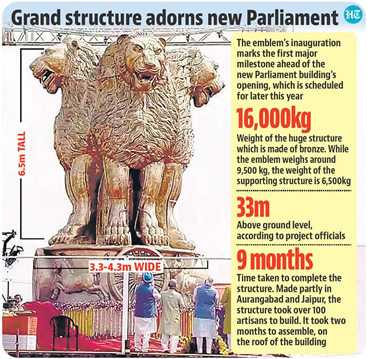

12th July 2022 (7 Topics)
Context
Prime Minister Narendra Modi unveiled the National Emblem cast on the roof of the new Parliament building.
About
The National Emblem
- Cast at the top of the Central Foyer of the new Parliament building, the 6.5-metre-high National Emblem is made of bronze, and weighs 9,500 kg.
- A supporting structure of steel weighing around 6,500 kg has been constructed to support the Emblem.
|
National Emblem:
|

The building’s interiors
- The new building will have six granite statues of important personalities, four galleries each for the two Houses of Parliament, three ceremonial foyers, three India galleries, and one Constitution gallery.
- Each wall in the building will have a dominant theme — dedicated, for instance, to the contribution of tribal leaders, or to showcasing the contribution of women.
- Displays including a mix of portraits, illustrative arts, installations, sculptures, and decorative art will frame storylines.
Architectural style
- Bimal Patel of HCP Designs, Ahmedabad, is the architect in charge of the building, which is triangular in shape, and incorporates architectural styles from around India.
- The building is coming up adjacent to the existing Parliament complex, and is of almost the same size.
- Seating capacity: The new Parliament House will have a seating arrangement of 888 members in the Lok Sabha. At present, India has 543 Lok Sabha seats.
- Similarly, 384 members will be able to sit in the Rajya Sabha of the new Parliament House, which currently has 245 seats.
- When a joint meeting of the two houses is convened at the new Parliament House, the hall earmarked for it will have a seating arrangement of 1,272 members. At present, the joint meeting of the two Houses is held at the Centre Hall with only 430 seats.
- The new Lok Sabha and Rajya Sabha halls will have increased seating capacities (888 and 384 seats, respectively) in anticipation of an expanded Parliament; a 25-year-old freeze on increasing state-wise distribution of seats ends in 2026.
- The building will have an open-sky area of 2,000 sq metres for a banyan tree.
Cost of the project
- The new Parliament building project was awarded to Tata Projects for Rs 971 crore.
- The estimated project cost has shot up by nearly 24 per cent to about Rs 1,200 crore due to additional works, changes in construction plan, and pandemic-related delays.
- The building is part of the Central Vista Project, which also includes a joint central secretariat, revamp of the Rajpath, a new Prime Minister’s residence, a new Prime Minister’s Office, and a new Vice-President’s enclave.
The current Parliament building
- The present Parliament House was inaugurated on January 18, 1927. Its architectural work was entrusted to Sir Herbert Baker.
- The giant circular building with its 144 sandstone columns was designed by Sir Edward Lutyens, who also designed the heart of Delhi – from the seat of the government in the North Block to the iconic Connaught Place.
- Sir Herbert Baker wanted the Parliament House to be triangle-shaped. A central hall should be built in between.
- But then British architect Sir Edwin Lutyens opposed it. He had suggested shaping it round in his proposal. Ignoring Herbert Baker's suggestion, the British had accepted Edwin Lutyens' proposal.
- The existing Parliament building will be conserved as an archaeological asset of the nation.

